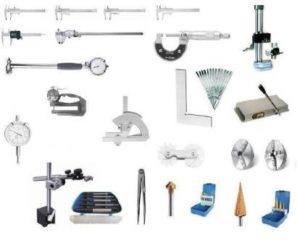Measuring Tools
1. Steel Rule
Steel rule is generally employed for purpose of measuring rough dimensions and laying out them. It is always advisable to start measuring from 1 cm mark because the end of the rule is generally worn out.
2. Circumference Rule
It is commonly used for measuring or laying out or as a straight edge. The specialty in this rule is that the circumference can be taken directly, below the diameter dimension.
3. Straight Edges
There are two types of straight edges namely four edge type (Fig.) and bridge type (Fig.) which are made of carbon tool steel and alloy steel. They are generally flat graduated bar of steel with one longitudinal edge beveled. Straight edges come in various lengths commonly varying from 2.5 mm up to one meter and above. They are mostly used for scribing long straight lines.
4. Flat Steel Squrae
It is a piece of flat hardened steel with graduations on either end. It is commonly used for marking lines in the perpendicular direction to any base line.
5. Scribers
Fig. shows the various types of scribers, which are sometimes called the metal worker’s pencil. These are made up of high carbon steel and are hardened from the front edge. Scriber is used for scratching lines on the sheet metal during the process of laying out a job.
6. Bever Protractor
The bevel protector (Fig.) is an instrument used for testing and measuring angles within the limits of five minutes accuracy. The common components of this instrument are base, disc which is fitted with a pivot at the centre and carries a datum line. On this pivot of the protector, the dial is allowed to rotate when the clamping nut is released. The other unit clamps the blade rigidly to the dial. The blade can be moved lengthwise. Vernier scale is also provided on the disc to take reading for accurate measurement. Dial is graduated in degrees over an arc.
7. Divider
It is used for marking and drawing circle and arcs on sheet metal.
8. Trammel
Trammel is used for marking and drawing large circles or arcs, which are beyond the scope of dividers.
9. Prick Punch
Fig. shows the prick punch, which is used for indentation marks. It is used to make small punch marks on layout lines in order to make them last longer. The angle of prick punch is generally ground to 30° or 40° whereas for centre punch it is kept 60 °or 90°.
10. Centre Punch
Fig. shows the centre punch, which is used for locating centre for indentation mark for drilling purposes.
11. Surface Gauge or Scribing Block
Fig. illustrate the surface gauge which is a principal marking tool used generally in the fitting and the machine shops. It is made in various forms and sizes. It consists of a cast iron sliding base fitted with a vertical steel rod. The scriber or marker is positioned or set into an adjustable device using a knurled nut at one end. The scriber can be loosened or tightened by means of the nut. The marker is used to set it at any desired inclination, moved to and fro inside the hole accommodating it or adjust its height along the vertical pillar.
It is commonly used in conjunction with either a surface plate or marking table. It is used for locating centres of round rod held in V- block, describing straight lines on work held firmly in its position by means of a suitable device like angle plate and also in drawing a number of lines parallel to a true surface.
This device is a very simple form of surface gauge and it is largely being replaced by a more accurate instrument called universal surface gauge.
12. Universal Surface Gauge
Fig. shows the universal surface gauge, which is an improved variety of the surface gauge simple scribing block. It is designed in such as way that appreciably finer adjustments can be made very quickly. It consists of a cast base perfectly machined and ground at the top, bottom and all sides. The base of the gauge usually carries a V-shaped slot at the bottom so as to render it suitable for use on round objects. Two guide pins are provided at the rear end of the base, which can be pressed down to project below the base of the gauge. These pins can also be used against the edge of the surface plate or any other finished surface for guiding the instrument during marking and scribing work. A swivel bolt is provided at the top of the base in which the spindle is fitted. This spindle can be swung and locked in any desired position by means of the adjusting screw, which is provided with a knurled nut at its end for this purpose. For marking purposes, the scriber is fitted in an adjustable screw on the spindle and is capable of being adjusted at any inclination and height along the spindle. A rocker is provided at the top of the base and it carries an adjusting screw at its rear end. During operation, the spindle is secured in the swivel bolt and is set at a desired inclination. The adjustable scriber is swiveled and set at approximately the required height. On bringing the point of the scriber at the exact correct height, finer adjustments are then made using adjusting screw provided on the rocker. Therefore, this gauge is commonly employed for scribing parallel lines at desired heights from a plane surface, comparing the trueness of two similar heights, setting out a desired height and similar other operations, and forms an indispensable instrument of bench work. Source A Textbook of Basic Manufacturing Processes and Workshop Technology by Rajender Singh.













Post Comment
You must be logged in to post a comment.